William ‘Bill’ Thornton BLUE
(January 31, 1902 Cape Girardeau, Missouri - April 1968, Trenton, New Jersey)
Clarinet and alto saxophone
with the Missourians then with Cab Calloway’s orchestra until January of fall 1931
Listen to Cab Calloway’s recordings from the early 1930s ... If your ear is dominated by a hopping, acrobatic and remarkably creative clarinet sound, you are enjoying one of the great forgotten musicians in the History of Jazz who spent more than 30 years in an asylum: William Thornton BLUE. It is my good friend the late Christian Bonnet (1945-2017) — whose ear was particularly demanding - that made me discover the talent of this clarinetist and alto saxophonist whose solos give a unique sound to the first Calloway shellacs... The Hi De Ho Blog will tell you the almost unknown story of the man who nicknamed himself “The reputed Blue”.
Advertisement for a Kings of Pythias concert.
Notice on the bottom right the portrait of Sergeant Arville Harris (St. Louis Argus, April 28, 1916)
Youth in St Louis and a famous father
William Thornton Blue is the son of William Blue (1877-1932) and Eva Hamis (1868-1933). He has two stepsisters: Katie (1892-1946) and Lillian (1900-1979) born from the mother’s previous marriage. According to the 1910 census, Katie was working as a “Musical Band Keeper”.
This proves that when your father is a music teacher and conductor of the very powerful and famous Pythian Brass Band in Saint Louis, you must have a certain inclination for the instruments. It seems that William Blue (exact namesake of his father) was initiated very early on the clarinet.
Born in 1877, Thornton’s father — most people called him “Professor”— also had his own William Blue’s Concert Band, as he was the bandmaster of the Blue and Harmony Band with James H. Harris as the leader. James was Arville Harris’s father, a future sax in Cab’s band!
Quoted by Dan Vernhettes in his fabulous book “Jazz Puzzles 2”, The Indianapolis Freeman dated June 1900 reports:
“Wm. Blue, who was bandmaster with the Melroy Chandler Minstrels last season, since has been bandmaster with Stowe’s Uncle Tom’s Cabin company, has returned to his home at Poplar Muff, Mo, and organized the K[ings] of P[ythian] First Regiment Band, of Flora lodge; N°15. Mr. Blue has worked hard for what he is known and is still practicing. He has been esteemed with the honor to instruct de Cape Girardeau band. About the 8th of August Mr. Blue has arranged to have a big band carnival, in which fifteen bands are to be presents. (…) He sends regards to all friends, especially to Henry Carter, Prof. A.H. Montgomery and Prof. P.G. Lowery.”
Dan adds that this press clip “illustrates that all the great bandmasters – of different states – who worked the minstrel circuit kept in touch for both social and professional reasons.”
About the father, Pops FOSTER writes in his biography:
“There was one guy named Thornton Blue who played real good trumpet, and I played in his band around 1912 or 1913. We mostly rehearsed and didn’t have no job. I also worked with him driving cotton wagons for Grants. Blue used to play very loud and at a funeral one day [on August 14, 1932] he was blowin’ so hard, he just dropped dead. He lived out in the Irish Channel and had his own little band.”
According to Vernhettes, in 1915, William conducted a 41-piece concert band. Although no draft registration card has been found for him (supposing he volunteered), we know that William Blue, Sr. sailed to Europe during World War I and was part of the 350th Field Artillery Band, led by Lieutenant J. Tim BRYMN, of Philadelphia. William Sr. was an assistant bandleader in Infantry Headquarters. Brymn’s band won fame in France (with or without William Blue!), and received a great welcome upon its return home in July 1919. William Blue Sr. was in the same boat than his boss Brymn.
Timm BRYMN
“The band has about 70 soloists, recruited ‘from the four corners of the earth,’” as its organizer, General Fred T. Austin, facetiously puts it” writes in 1919 Emmett J. Scott in his book American Negro in the World War. Brymn orchestra’s itinerary in France is detailed online by Peter M. Lefferts. I don’t know if Blue, Sr. remained for a while with the orchestra after the war while it stayed in Philadelphia and toured the USA. I suppose he preferred to come back to his home in St Louis, where his wife Eva was waiting for him, 2655 Bernard St.
William "Professor" BLUE's grave in St. Louis.
In 1984, drummer Harry DIAL wrote a very interesting letter reprinted in Storyville magazine (#154, 1993) where he says:
“On Thornton Blue and Walter Thomas [read our article about him], I lived right around the comer from the Blue family when I was only six years old. Thornton had no brothers or sisters that I know of, it was just the mother, father and him.
His father was the bandmaster of the Pythian brass band, Bob Shoffner, Eddie Allen, Willie Austin, Floyd Casey, Ernest Graham and a host of others were products from that band, Thornton grew to be six feet tall or maybe slightly over.
My address at that time was 2744 Clark Avenue and the Blues lived around the corner on Garrison Avenue, I don’t recall the address. Around St. Louis, Walter was not considered in the class with Thornton, I don’t know how they were compared in later years out of St. Louis.”
The young Adolphus (not yet 'Doc') CHEATHAM
with the saxophone he probably sold to Thornton Blue.
Another interesting connection: in the early 1920s, Adolphus ‘Doc’ Cheatham, who just had a revelation while listening to Louis Armstrong, decided to abandon the saxophone for the trumpet. He sold his Melody-C for a few dollars to Thornton Blue. But when Doc Cheatham returns as Cab’s first trumpet, Blue will already be gone...
Encouraging beginnings with P.G. Lowery
As early as 1920 debuting his professional career, William Blue Junior is already noticed in P.G. LOWERY’s orchestra “the greatest colored bandmaster of the greatest jazz band in the world”. In this orchestra, which tours with vaudeville and the Ringling Brothers and the Barnum & Bailey circuses, William Blue already crosses paths with the trumpeter R.Q. Dickerson (whom he will find in several orchestras before Cab Calloway’s), Charles Creath, Willy Bunk Johnson, Earl Granstaff, Alvin Zoo Robertson, Harvey Lankford and Horace Eubanks. It must be said that Lowery, talented cornet soloist, had acquired the reputation of training musicians with exigency and getting the best of them. In its November 13, 1920 edition, the Indianapolis Freeman quoted by Lynn Abbott and Doug Seroff in their incredible book “Ragged But Right” remarks on William Blue Jr. in its article about the P.G. Lowery season:
“The entire season was one ideal trip, opening in New York City, March 25, traveling through thirty states. P.G. Lowery’s band did great credit to themselves, also their director in six-week engagement in the Madison Square Garden, New York City. The engagement consisted of the grand entry and playing a feature act in the big show performance, including full salary and expenses… The formation of the band was very good and the parts were artistically handled by each member. William Blue, the clarinetist from St. Louis, proved himself a feature in the band. Next comes the cornet section, consisting of Thomas May, the old reliable circus performer, who has held the solo seat for years, assisted by R.Q. Dickerson, one of St. Louis’ best cornetists, ably assisted by Richard Jasper of Huntington, W. Va. (…) Mr. Lowery wishes to thank each and every one for their conduct and courteous work in making the Lowery Band a pattern for all bands.”
The band consisted in:
- William Blue Jr.: clarinet
- Thomas May, R.Q. Dickerson, Richard Jasper: cornet
- Charles Evans, Ed Tolliver, James Young: alto saxophone
- Redus Horton, H.M. Lankford, A.H. Bass: trombone
- Winston Walker, Alvin ‘Zoo’ Robertson: baritone saxophone
- Walter Coleman: saxophone
- William May: bass
- Walter Coleman, Victor Miller, James Holmes: drums
Abbott and Seroff point out: “Lowery’s roster never featured so many illustrious jazz musicians as it did in 1920, and after the season ended his band was no longer referred to as a ‘jazz band’”.
In 1921, Thornton Blue is in a trio in one of the cabarets in St. Louis, accompanied by pianist George REYNOLDS (who had played years before with Jelly Roll MORTON while the latter was singing) and Lawrence MADISON (who had been in Thornton’s father’s orchestra) on drums.
In Jazz Puzzles 2, Dan Vernhettes points out the ad for a musical contest that will occur on the steamer Majestic (The St Louis Argus, July 29, 1921). Leading local jazz bands are invited to compete in order to know who’s the best Jazz band in St. Louis: Chas Creath’s Jazz-O-Maniacs (organizer of the contest!), Stephenson and Jackson, So Different Syncopators, Mammies Harris’ Select Jazzers, Babe Ambrose Jazz Babies, Leroy Pickett’s East Side Jazzers and the white group Majestic Jazzers.
Blue Devils, Chas Creath, Dewey Jackson, the Cotton Club Orchestra...
In 1923, at the age of 21, he joins another traveling troupe, that of the blackface comedian, Billy King's Road show, whose orchestra is better known as the Blue Devils. In its ranks, however, there are the likes of Walter Page, Hot Lips Page, and Eddie Durham. Their story is evoked in the famous documentary film "The Last of The Blue Devils".
William Thornton Blue then joins Wilson ROBINSON’s Bostonians, which later become known as Andrew PREER’s Orchestra, the Cotton Club Orchestra, and then the Missourians! We have already told you about the adventures of this orchestra through the life of pianist Earres PRINCE.
Blue remains only a short time with this first version of the future Missourians. He will come back to it in a few years, as we shall see.
Charlies 'Chas' CREATH
In the meantime, he settles for a while in Saint Louis to work on the river for Streckfus Steamers with the trumpeter Charlie CREATH with whom he records. On the 1924 titles with Creath’s Jazz-O-Maniacs, some compare his solos with those of the great Johnny DODDS! Just listen to Pleasure Mad to be convinced!
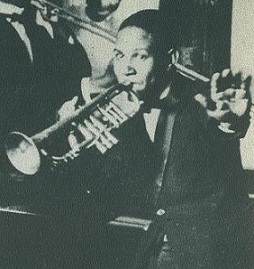
Dewey JACKSON
He joins Dewey JACKSON between 1924 and 1927 and leaves for New Orleans at the end of 1925. It is probably at this point that he works with Fate MARABLE on the steamer St. Paul. Also on board are Henry Red Allen, Shirley Clay, Charlie Creath, Albert Snaer and Sammy Long.
The three tracks recorded in 1926 with Dewey Jackson (She’s Crying For Me, Capitol Blues and Going to Town) each have a powerful solo from Thornton Blue (with a clear preference on my part for Capitol Blues). Jackson even shouts out “Blue!” on Capitol Blues to announce his clarinetist!
After Dewey Jackson, Thornton Blue permanently joins the Cotton Club orchestra, then headed by Andy PREER. Indeed Dewey Jackson seems to have gone with Thornton to try his luck with the Cotton Club orchestra during the winter of 1926... The session of February 3, 1927 allows us to hear a beautiful work of the reeds section on I’ve Found A New Baby.
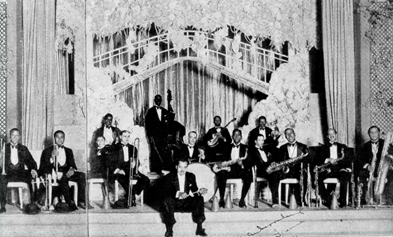
The Noble Sissle Orchestra at the Ambassadeurs, Paris.
William Thornton Blue is the 3rd starting from the right. Sidney Bechet is on the right.
Tour in France with Noble Sissle
But it was on September 17, 1928 that Blue realizes his first hour of glory: the St. Louis Argus, African-American newspaper, announces the departure of “Thornton Blue and his orchestra” for Europe. In reality, he’s going to France to play with Noble SISSLE who, after a huge success at the café "Les Ambassadeurs," has won a contract in Biarritz for the whole month of September, before leaving for England in the fall. It was John Ricks who assembled the musicians and obtained their passports in a few days: Dave Richard (cornet), Otto Hardwick (alto sax and Ellington alumni). William Blue is mentioned there as tenor sax... So, the group even travels in first class on the S.S. Rochambeau! In Paris, Johnny DUNN and Sidney BECHET have already been recruited.
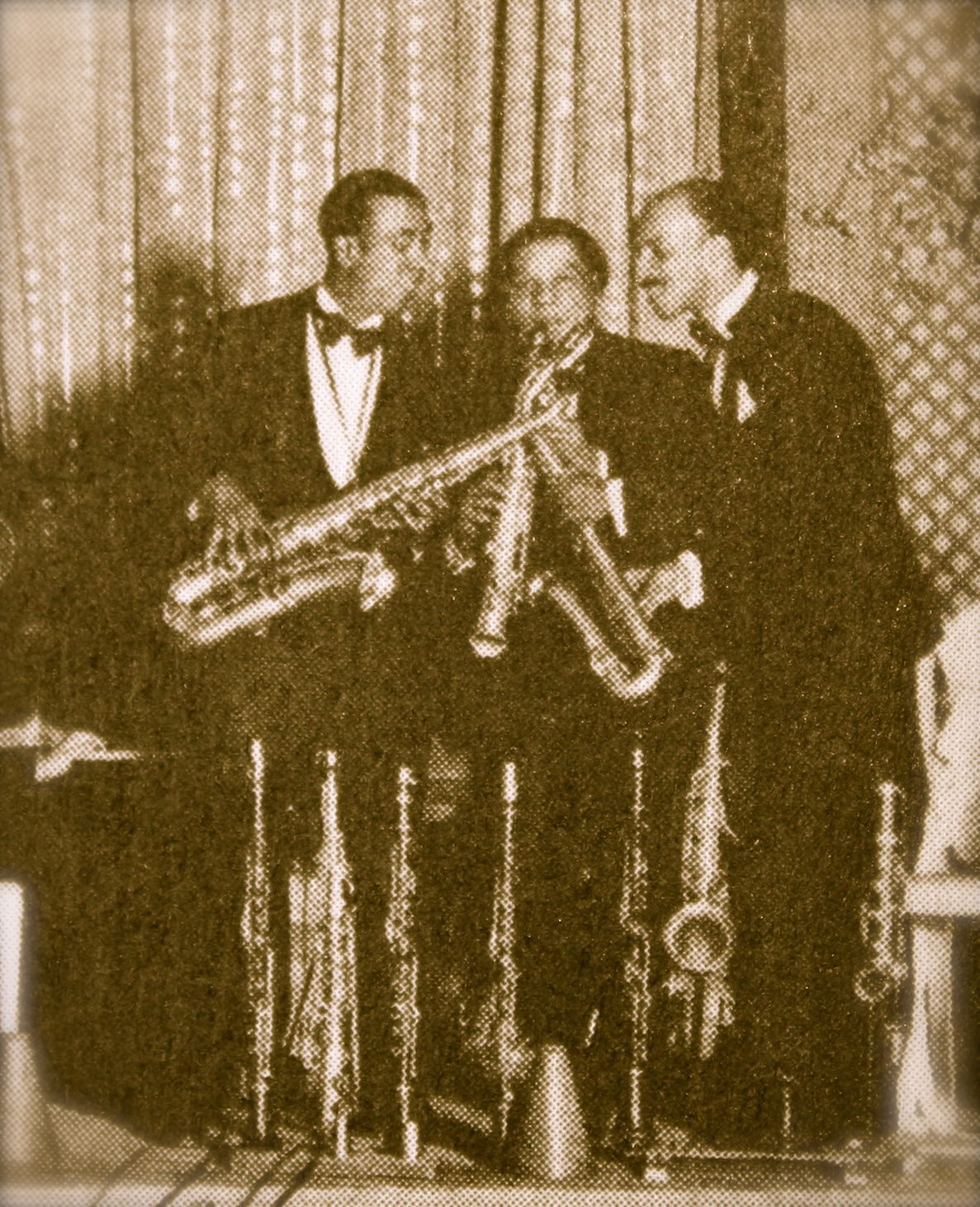
William Thornton Blue (on the tenor sax ...), Sidney Bechet and Otto Hardwick
in the Noble Sissle orchestra, Les Ambassadeurs, Paris, 1928.
Photo: Frank Driggs collection
With Sissle, Thornton Blue spends the autumn on the French Atlantic coast and returns to the USA to find the band called The Missourians. I do not currently have the exact date on which Blue joined them.
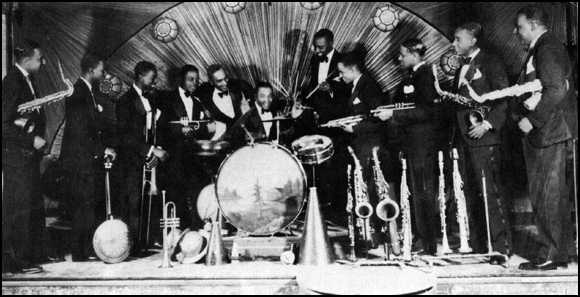
The Missourians in 1929. Will Thornton Blue is the 1st on the right.
The Missourians, stars of the Savoy Ballroom
In the company of the Missourians, who play at the Savoy Ballroom in Harlem, where they are the featured orchestra, Blue will soon meet Cab Calloway, who will be leading the Alabamians in a historic duel (which we have already spoken of many times).
Blue appears in the three recording sessions with the Missourians:
- June 3, 1929 in New York for 4 tracks, including Market Street Stomp where he can be heard in particular.
- August 1, 1929 for 4 titles where Thornton Blue is heard during 32 bars on “400” Hop. But Vine Street Drag is the best solo for him on the session.
- February 17, 1930 for 4 titles including Two Hundred Squabble and Prohibition Blues. Some assume that Cab Calloway was already present at this last session...
But Blue changes direction, leaving and returning, not being exclusively attached to the Missourians in spite of the numerous bandmates with whom he shares origins. We find him in very good company:
- February 1, 1930, with Louis ARMSTRONG and Luis RUSSELL and his orchestra where he replaces the famous Albert Nicholas for two titles.
- On February 18, 1930, with Henry Red ALLEN and his orchestra for four titles, and his solos on You Might Get Better But You’ll Never Get Well, Everything Shout (great solo on this one) and on Dancing Dave; all are perfectly in the style of the group where Blue only makes periodic replacements.
A young leader in his prime: Cab Calloway
A few bars with Cab Calloway and then he goes away.
Under Cab Calloway’s era, the Missourians quickly become one of the most popular orchestras in New York. They follow theater commitments in Manhattan, Harlem and the East Coast. And while the recording industry is in crisis like the rest of the nation, the group — now known as “Cab Calloway and his Orchestra” — will enter the studio four times in 5 months between July and December 1930.
They will record among the wildest tracks of the year including Happy Feet and Nobody’s Sweetheart that figure on the top-list of Will Thornton Blue (listen to them below).
The genius and indispensable CD edition Masters Of Jazz has dissected all the titles in volume 2 devoted to Cab and has identified the solos of each one. Let his happy readers plunge again into the booklet to confront their opinion of the sharp ears of its experts (including Christian Bonnet, Philippe Baudoin and their associates).
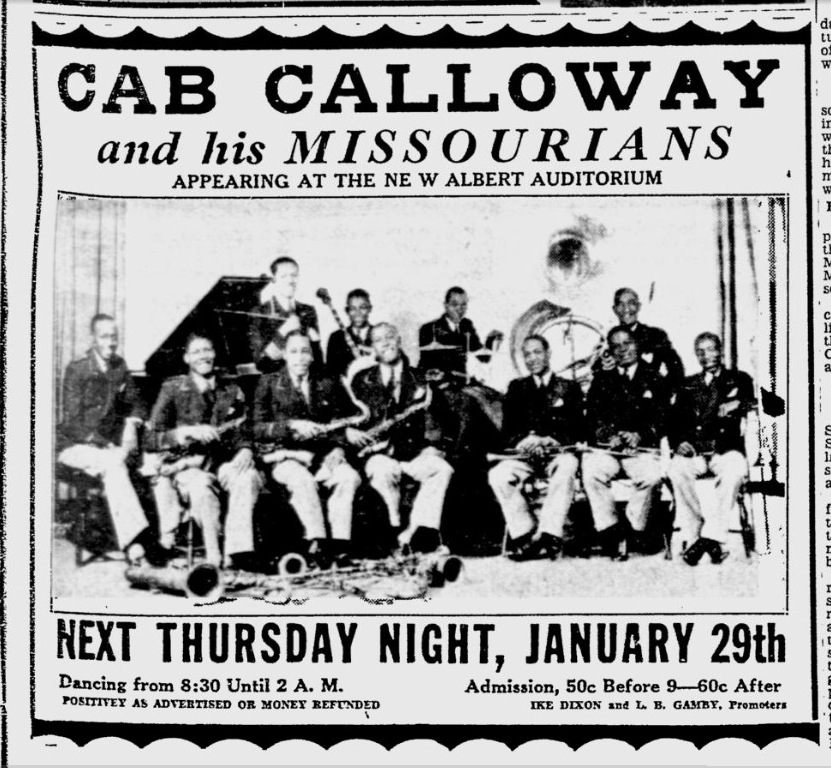
Undoubtedly one of the last appearances of Thornton Blue (3rd sax from the left)
in the Missourians, January 29, 1931:
on February 4, 1931, the orchestra became part of the Cotton Club.
According to Alyn SHIPTON, William Thornton Blue is the first to leave the orchestra when Cab moves to the Cotton Club in February 1931. Is this a voluntary departure? Or is he part of the first purge that Calloway carries out among the former Missourians to enhance his authority? It is in any case really a pity because the clarinet of Thornton Blue perfectly answered the vocal madness and eccentricities of the singer.
Best examples are, as I said earlier, on Nobody’s Sweetheart (December 23, 1930) of “Blue’s shrill, bright, and very eccentric clarinet […] in all its raspy dirty overblown effectiveness” (in Gunther SCHULLER, The Swing Era, 1989). On this very number, Tony Baldwin in the liner notes for Cab Calloway’s CD boxset Wah-Dee-Dah insists:
“Of the original players in the band, one of the most distinctive solo voices was that of clarinetist William Thornton Blue. Curiously, the distortion inherent in the Brunswick label’s so-called ‘Light-Ray’ recording system seems to suit Blue’s impassioned playing, sometimes to extraordinarily powerful effect, as on Nobody’s Sweetheart.”
But my all-time favorites of Thornton Blue’s talent is definitely on Happy Feet, his “masterpiece” recorded on October 14, 1930 in New York.
Arville HARRIS, long childhood friend
who replaces William Thornton Blue in 1931
And do you know who takes Blue’s chair in Cab orchestra? His childhood buddy, Arville “Bunky” HARRIS of whom we spoke of at the very beginning of this article! He is already present at the session of February 17, 1931. But, it looks like Cab kept searching for a replacement for Blue, willing to sound as good as Duke Ellington's orchestra for his new Cotton Club engagement, because he asked Jimmie NOONE to join the band in Spring 1931. As source states in Jazz Information (October 4, 1940), "Cab wanted a clarinet that wouldn't be a bringdown from Jimmie's boyhood friend Barney Bigard." Noone decided to take his own band to New York and make his own trail.
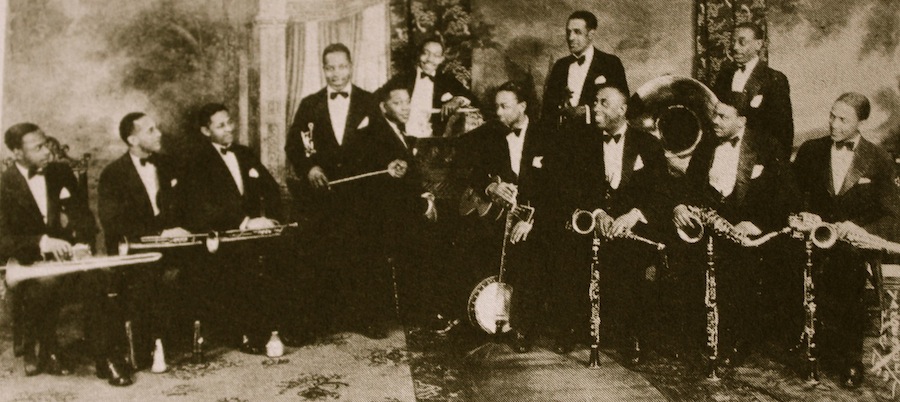
The orchestra of Dave Nelson (Thornton Blue is the 4th from the right)
Photo: collection Frank Driggs
The trail of Thornton BLUE is found in Dave NELSON’s Orchestra (the nephew of King OLIVER) probably from mid-1931. Next to him is the young banjoist Danny BARKER who will join the Cab Calloway orchestra a few years later. Charlie ELGAR’s band where Barney BIGARD had played in 1927 also welcomed William Thornton Blue’s reeds.
Unfortunately, no recording session exists for those last engagements. Thornton Blue’s career ended abruptly, almost as quickly in the memories of the History of Jazz, except for the sharp ears and endeavors of some savvy connoisseurs – which you might be since you’re reading these lines!
A contemporary view of Trenton asylum in decay, where Thornton Blue spent his last years.
Mental disorders and life in an asylum until death
As Alyn Shipton judiciously points out, Thornton Blue can be found in discographies with Cab Calloway in 1935; but in reality, he had disappeared from the radars and this mistake was passed along in one of the first of Cab’s discographies and was repeated until now.
It must be said that the health of Thornton Blue seems to be faltering early.
In the 1940 Census, William Blue is located at Marlboro Psychiatric Hospital in New Jersey.
Aerial view of the Marlboro Psychiatric Hospital in the Thirties.
Composed of 17 “state of the art” cottages and central buildings, the Marlboro Psychiatric Hospital opened in early 1931. The landscape’s property was mostly a rural environment. It opened with a capacity to accommodate 500-800 patients.
On the census, the guy in charge indicates that William was already in an institution in 1935 like most of the guys on the same sheet. From this document, Blue was married but no name is given.
It seems that William Blue is later transferred to the New Jersey State Hospital, another mental institution in Trenton, New Jersey, where he spends the rest of his life.
According to The Line Up website, Trenton “was the first public institution to employ the Kirkbride Plan, which promoted patient privacy and a welcoming, naturally lit environment. In 1907, Dr. Henry Cotton became the hospital’s medical director.” Wikipedia adds: “In 1907, Dr. Henry Cotton became the medical director. Believing that infections were the key to mental illness, he had his staff remove teeth and various other body parts [like stomachs, colons, testicles, ovaries, teeth or tonsils removal] that might become infected from the hospital patients. Cotton’s legacy of hundreds of fatalities and thousands of maimed and mutilated patients did not end with his leaving Trenton in 1930 or his death in 1933; in fact, removal of patients’ teeth at the Trenton asylum was still the norm until 1960.” Let’s hope that as a former reeds player, Thornton Blue hasn’t got his teeth removed…
Some spoke of a death in 1968, others in 1948, still others – like me – in 1938, since the oldest seemed to me most likely.
But thanks to Dan Vernhettes who provided me his death certificate, we can attest that William Blue indeed died in 1968. Now, just think about this great musician who spent more than thirty years in mental institutions…
In fact, this kind of story happened to more jazz artists than you’d think. For starting with Buddy BOLDEN (1877-1931) in New Orleans who died in 1931, 24 years after being arrested for “insane behavior”. Before the post WWII musicians got trapped in drug abuse and developed severe mental issues, or individual cases like Thelonious MONK or Bud POWELL, there is indeed a great deal of folks like Thornton Blue who had psychiatric troubles, like clarinetist Leon ROPPOLO (1902-1943) from the famous New Orleans Rhythm Kings, confined to a mental institution for the majority of his life starting 1925, except for a brief release in early 40s (note that during his stay at the asylum he continued to play and organize his own band). Alcohol, drugs, syphilis or simply the hard days work Milt Hinton even pointed that a lot of musicians who left Cab’s orchestra got depressed and never been able to relieve – healthy and professionally. I’d think of R.Q. DICKERSON (tp), Earres PRINCE (p), Jimmy SMITH (b and tb), Andrew BROWN (sax)…
William Thornton Blue is buried along his sister, his mother and father at St Peter’s Cemetery in St. Louis, his hometown and that of his friends in Missouri.
BLUE's family grave in St. Louis Cemetery.
Thornton Blue rests with his parents and siblings.
Influences and reputation among jazzmen
In his autobiography, drummer Harry DIAL explains that discussions were going on in St. Louis to find out which of Sidney COSTELLO, Jerome PASQUALL or Thornton Blue was the best. He says that Andrew BROWN and Walter Foots THOMAS were both of a lower level at that time (mid-1920s).
Nevertheless, consider that when he was first playing on-board steamers on the Mississippi, his bandmatesWTB already held Blue in high esteem. For instance, Gene SEDRIC has apparently always considered Thornton Blue as a major influence on his playing, since his days in Creath orchestra.
Same idea from the saxophonist Benny WATERS who once explained to French clarinetist Marc RICHARD that besides Earl BOSTIC, whom he considered the king of jam sessions, Bill Blue was one of the “great killers” of his kind!
In his book Jazz of the Thirties, Rex STEWART explains that at the time Barney BIGARD became part of the Duke ELLINGTON orchestra, among the great clarinet players around New York was “William Thornton Blue with an inimitable buzz style (…) featured with the Missourians.”
What saved Bigard is that in Harlem no one had ever heard of this Chicagoan. Stewart tells us that one of the guys at the Cotton Club went to the Rhythm Club (the place where all the musicians met to find a job or to jam) and announced that the orchestra, Ellington was the best. He evaluated the musicians (at that time, few had heard the Ellingtonians in person since they only played at the Cotton Club, forbidden to Blacks) without raising enthusiasm, but when he passed to Bigard, no one knew him except for another guy from Chicago, Happy Caldwell. It was William Thornton Blue who challenged Bigard the next day at the Rhythm Club. Rex develops the story:
“Such public challenges were rare, but sure enough, the next night the Rhythm Club was packed. Blue told Bobby Henderson an up-and-coping piano man, to play The World Is Waiting For the Sunrise in a very fast tempo. Then Blue proceeded to play the devil out of the song, swinging with his familiar growl (a vibration emanating from the throat […]).
On this night, old Blue was blowing in extra fine form. He took the house until… It was Barney’s turn. He damn near split our eardrums, opening his chorus with a wild screaming high note, which he held all through the first chorus. Then he played the second chorus with lots of what Ellington later called ‘waterfalls’, which I can only describe as sounding like chromatics, except that when one analyzes the passages, they prove not to be true chromatics at all.
Barney glissed, swooped, soared, making his clarinet smoke to the point that Blue packed up his horn and said, “Well, Barney, I guess Jonesy [a Cotton Club waiter at the origin of the battle] was telling the truth. I’ll be in Big John’s, and the drinks are on me.”
Rex STEWART believes that Thornton Blue’s growl influenced Benny GOODMAN’s in Somebody’s Sweetheart of 1931, when the young Benny learned from him during Harlem jam sessions. In his book, Rex STEWART recalls that one night Thornton Blue “carved Benny Goodman to ribbons playing Sweet Georgia Brown” during a jam session. In the same way, Thornton Blue left the place with his clarinet between his legs when Buster BAILEY had dropped everyone dead holding the note for 4 minutes on Tiger Rag before going on in the same breath for 15 choruses! It was probably to take revenge for the time Thornton Blue had executed Bailey and Omer SIMEON (anecdote narrated by Whitney Balliett in “American Musicians II”).
,
The French conductor and clarinetist Marc RICHARD is one of Thornton Blue great fans, discovering him thanks to a reissue of the Missourians in the Panassié series Trésors de Jazz. We can also welcome the fact that he is the first to have written an article concerning him in the French Dictionnaire du Jazz. Only Chilton’s Who’s Who of Jazz had done it before. It is probably not a coincidence that one of the first orchestras inwhich he played was called “Jazz O'Maniacs”, named after the Chas Creath’s band.
Thanks to the few preserved recordings, we can appreciate his great mastery of the instrument and his way of playing, very eccentric and uninhibited, unbridled, with a very strong tongue attack. Marc Richard: “One of the greatest soloists of the late 20s. On the clarinet as on the alto sax, his style, very original, combines swing, virtuosity overflowing with verve and exuberant phrasing.” William Thornton Blue was a very inventive clarinetist.
Let’s listen to him again to convince us and not forget him!
Our Top 5 playlist:
- Happy Feet (with Cab Calloway)
- Two Hundred Squabble (Missourians)
- Nobody’s Sweetheart (with Cab Calloway)
- Market Street Stomp (Missourians)
- Prohibition Blues (Missourians)
William Thornton Blue’s SOLOGRAPHY
With Jan EVENSMO, creator of the world famous Solographies series and curator of the indispensable website JAZZ ARCHEOLOGY, we tried in 2017 to set William Thornton Blue's SOLOGRAPHY.
Enjoy and if you find mistakes or omissions, let us know!
Sources:
- Ragged But Right: Black Traveling Shows, Coon Songs and the Dark Pathway, Lynn Abbott and Doug Seroff
- American Musicians II, Whitney Balliett
- That Got 'Em, Mark Berresford
- On and Off the Bandstand, Arthur Bradley
- Ride, Red, Ride: The Life of Henry Red Allen, John Chilton
- Who's Who of Jazz, John Chilton
- One O'Clock Jump, The unforgettable history of the Oklahoma City Blue Devils, Douglas Henry Daniels, Beacon Press
- All This Jazz About Jazz, Harry Dial
- Storyville magazine (#154, 1993), Harry Dial Letter
- Black Beauty, White Heat, Frank Driggs
- Jazz on the River, William Howland Kennedy
- Dictionnaire du Jazz, article by Marc Richard about Blue
- City of Gabriels: The History of Jazz in St. Louis, 1895-1973, Dennis Owsley
- The Swing Era, Gunther Schuller
- Hi De Ho, The Life of Cab Calloway, Alyn Shipton
- Jazz and Death: Medical Profiles of Jazz Greats, by Frederick J. Spencer, 2002
- Boy Meets Horn, Rex Stewart
- Pops Foster: The Autobiography of a New Orleans Jazzman as Told to Tom Stoddard, Tomm Stoddard
- The Duke Ellington Reader, Mark Tucker
- Jazz Puzzles, Vol. 2, Dan Vernhettes, 2015 (order at www.jazzedit.org)
- Website Devil At The Confluence
- Website Hub Pages
- Website Find A Grave
- Website Forgotten Photography
- Website Funny Junk
- Website Jazz Age Club
- Website "Rhythm of the Day"
- Website Swing FM Asso
- Website The Line Up
- The New York Age, September 15, 1928


